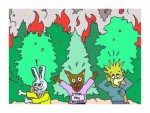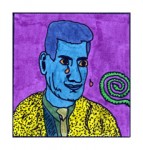 All right, enough already! The sexual tension between these two forms is driving me nuts. Nobody buys this mutual dislike as anything but a prelude to getting a room and making babies. Get on with it!
All right, enough already! The sexual tension between these two forms is driving me nuts. Nobody buys this mutual dislike as anything but a prelude to getting a room and making babies. Get on with it!
For a long time we had a bunch of privileged intellectuals manufacturing consent by dividing the peanut butter and the celery between LIT and RACY, also known as high and low literature. The “stuff that matters” from the unwashed laundry of the masses who don’t count because they are the bewildered herd and must be told what to value.
Along comes the E in Ebook and all of a sudden Pbooks are revealed for what they are—form, not the actual consciousness that inspires culture. The entire social control mechanism that maintains access to distribution to consciousness is laid bare. People naturally begin to ask questions, particularly those in the bewildered herd who have never known expression before.
That delicious E is the hammer in the Apple ad. Thor’s hammer, the bolt of the storm that is the Aquarian lightning age, connecting thought. The contact that is the point of all literature both high and low, author and reader touching each other, both one and apart, oscillating in response. AUM.
In that moment of explosion, she joins the LIT and the RACY into LITERACY, one of the more stunning discoveries of this medieval age of thinking. Now paper (earth) can be thought (air) and vice versa.
This is an unavoidable revolution in consciousness occurring right before our eyes. As this bolt of electricity strikes earth and ignites a firestorm in the forest of paper, a lot of people are going to have to flee for their lives as their comfortable burrows and nests burn to the ground.
Make no mistake; this is a painful thing for a lot of ordinary folks who depend on the old growth forest for their lives. But understand those who welcome the change as well as those who cringe in the foliage. Everybody, and I mean EVERY BODY on any side of the fence is in on this. We all get to participate as the forest burns down around our ears. Open your heart and listen to the things you haven’t heard.
I emphasize with the struggle; those about to be hurt by the flames could be me, or someone I care about. I’m excited and terrified both—where do I run? Where do you run? Who is already cut off from the lake—wait, is this the dry season? That cave a safe haven or a future oven filled with smoke? What is right action? Shock the monkey!
It is a time for fear.
The copyright-royalty model is outdated and inefficient. It is primarily a system for putting access to the forms of consciousness into the hands of concentrated centers of impersonal power, justified by projecting an image of the properly compensated and approved artist for their labors.
Don’t delve too far into that model—for every lucky artist you’ll find thousands ripped off, their rights in the vault of some conceptual entity that doesn’t count as a moral agent. The millions who don’t get to participate at all because only “artists” can do that stuff? They get to pay to know what they think.
Alternate economic models and mechanisms of access have been out for years. Novels were the death of real books, just as recordable audiotape was the death of records and libraries would destroy bookstores. Those with privilege, who stand to lose the most by sharing, always cry bitterly when community insists that people raise their standard of living more humanely. Specialists are going to have to share their space with more generalists.
Access to data is still affected by class. The decline of fossil fuels and rare metals leads to a cage match between military contracts and consumer electronic manufacturers. The iron rule of oligarchy always obtains. But humans are naturally moral and strive for freedom. The human condition is nature’s way of making us figure it out.
The Kindle and the iPad are already ancient history. You think that’s what the kids are using? I’ll let that one be a surprise. Developers hate Apple. Who is going to put Ebooks in the hands of starving villagers with a credit card?
The price for everything is inflated. People want what they want now and they want to pay what they want to pay. You going to tell the vast majority of mindless beasts how to think? Good luck! Prices will have to fall and the money to be made will shrink. Subscriptions and proprietary ala Carte tollbooths are yesterday’s memories. Get used to it, what you think is right doesn’t matter.
How are you going to control the exchange of thoughts? No, seriously? Actions can be directed with a truncheon or a lawsuit, but you going to tell people what to do with their thoughts? Even brutal dictatorships let people think what they want as long as they obey. Rust always trumps the iron rule in the end.
Nobody can predict the future. If you think that’s what I’m doing you aren’t paying attention. Invigorated by the conflagration, the forest will grow back. The new life is always greater than the old. The status quo is death; plenty of new species will migrate to fill the void. That’s the scary thought—who will be the new neighbor? Won’t you be my neighbor?
The playing field gained a new dimension as well as a new form. This isn’t squeezing anything out; it’s rather that the old way of doing things is not going to dominate any more. It will have to content itself with being a smaller fraction of a greater whole.
Yes, this means even the crap gets a say. Or do you mean “the crap we don’t approve of”? I say let the crap hounds have their say and show us what they got. If they can’t ante up they’ll make for some fine fertilizer in the new forest. Freedom of speech means the right to participate alongside the great names and have your turn to speak—look at any sportscaster program with call-ins.
All of us start at the Level Zero crap hound bottom. Never forget we all begin in ignorance and grow according to many variables outside our conscious control. It’s in all our interests to create ecosystems of variable creative exploration. It’ll do both the wizards and the crap hounds some good.
Physical objects are totems to show allegiance. Don’t underestimate that. Also keep in mind that whatever is not nailed down is mine and whatever I can pry loose is not nailed down. Thoughts want to be free, so let them be so! Air always escapes a prison. The point is to hook up people who have an affinity with your thoughts and gratify them with stuff they actually want.
Youth culture is already doing this. They grow up with everything that ever was at their fingertips, creating their own wants and satisfying their own curiosity. Literacy is exploding like a thunderbolt. Get out of the way if you can’t lend a hand.
Doomsday fantasies of resentment can eat my shorts. We’re already there. The hum of the lightning age moves through an emerging electro-agrarianism that will bring both a shadow we’ve never encountered before and a worldwide literacy the likes of which cannot be conceived of.
Just wait until you see the child Pbook and Ebook make together.
The hybrid is the message of the savior of humanity, believe it!


